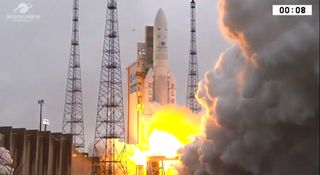Ariane 5 Rocket Launches Satellites Into Orbit for Saudi Arabia and India
A European-built rocket soared into the February sky over French Guiana Tuesday (Feb. 5), carrying two communications satellites into orbit in the first launch of 2019 for Arianespace.
The mission's Ariane 5 rocket lifted off today (Feb. 5) at 4:01 p.m. EST (2101 GMT) from the Guiana Space Center in Kourou, French Guiana. The heavy-lift booster delivered to Earth orbit the GSAT-31 satellite for the Indian Space Research Organisation (ISRO), as well as a "condosat" carrying two communications payloads — the Saudi Geostationary Satellite 1 (SGS-1) and the Hellas Sat 4 (HS-4).
SGS-1 "will provide advanced Ka-band spot beam communications services for the Kingdom of Saudi Arabia's KACST, including secure communications for the Gulf Cooperative Council region," Arianespace representatives wrote in a mission description. (KACST is a government organization that promotes science and technology in Saudi Arabia.)

HS-4 "will offer advanced Ku-band regional beam communications services for Arabsat's subsidiary Hellas Sat, a Greek-Cypriot satellite operator which provides services to leading Direct-to-Home (DTH) operators by delivering contents to more than 3 million households," Arianespace representatives added.
GSAT-31, for its part, will provide a broad range of communications services to people throughout the Indian subcontinent and the Indian Ocean region, ISRO officials have said.
Both GSAT-31 and SGS-1-HS-4 will operate from geostationary orbit, about 22,200 miles (35,700 kilometers) above Earth. At that altitude, an object's orbital period matches Earth's rotational period, meaning satellites keep the same patch of planet beneath them at all times. This is great for communications satellites, because they never disappear from their ground stations' sights.
GSAT-31 and SGS-1-HS-4 are designed to operate for at least 15 years, Arianespace representatives said.
Get the Space.com Newsletter
Breaking space news, the latest updates on rocket launches, skywatching events and more!
Today's launch was the first of the year for France-based Arianespace and the 103rd Ariane 5 mission overall.
Mike Wall's book about the search for alien life, "Out There" (Grand Central Publishing, 2018; illustrated by Karl Tate) is out now. Follow him on Twitter @michaeldwall. Follow us @Spacedotcom or Facebook. Originally published on Space.com.
Join our Space Forums to keep talking space on the latest missions, night sky and more! And if you have a news tip, correction or comment, let us know at: community@space.com.

Michael Wall is a Senior Space Writer with Space.com and joined the team in 2010. He primarily covers exoplanets, spaceflight and military space, but has been known to dabble in the space art beat. His book about the search for alien life, "Out There," was published on Nov. 13, 2018. Before becoming a science writer, Michael worked as a herpetologist and wildlife biologist. He has a Ph.D. in evolutionary biology from the University of Sydney, Australia, a bachelor's degree from the University of Arizona, and a graduate certificate in science writing from the University of California, Santa Cruz. To find out what his latest project is, you can follow Michael on Twitter.
